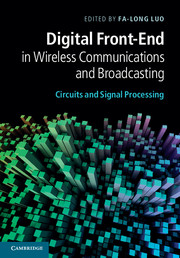Book contents
- Frontmatter
- Contents
- Contributors
- Preface
- Part I Introduction to digital front-end
- Part II DPD and CFR
- Part III DUC, DDC, ADC, DAC, and NCO
- Part IV Digital calibration, imbalance compensation, and error corrections
- Part V Circuits and system integration in digital front-end
- 20 Integration and interface of digital front-end with analog front-end
- 21 Circuits and systems for digital front-ends to support multiple wireless standards
- 22 Programming models and implementation platforms for software defined radio configuration
- 23 Programmable discrete-time integrated receiver front-ends
- 24 Multi-port front-end and transceivers for V-band multi-gigabit/s communication systems
- 25 Cross-layer design and digital front-end for cognitive wireless link
- Index
- References
22 - Programming models and implementation platforms for software defined radio configuration
from Part V - Circuits and system integration in digital front-end
Published online by Cambridge University Press: 07 October 2011
- Frontmatter
- Contents
- Contributors
- Preface
- Part I Introduction to digital front-end
- Part II DPD and CFR
- Part III DUC, DDC, ADC, DAC, and NCO
- Part IV Digital calibration, imbalance compensation, and error corrections
- Part V Circuits and system integration in digital front-end
- 20 Integration and interface of digital front-end with analog front-end
- 21 Circuits and systems for digital front-ends to support multiple wireless standards
- 22 Programming models and implementation platforms for software defined radio configuration
- 23 Programmable discrete-time integrated receiver front-ends
- 24 Multi-port front-end and transceivers for V-band multi-gigabit/s communication systems
- 25 Cross-layer design and digital front-end for cognitive wireless link
- Index
- References
Summary
Introduction
Software means programmable. Hence software defined radio means that the radio should now be programmable. We know what computer programming means, and we agree, up to a certain level, on how it should be done. But do we know what programming a radio means? Several questions are still open: what will an SDR platform look like in ten years? Will there exist software radio code? What will be the technical challenges and commercial issues behind this code?
Programming is more precise than configuring or tuning, it implies a much greater level of freedom for the programmer. But it also means much cheaper implementations in many cases and in particular a re-use of the same hardware for different protocols (i.e. with different programs). This is, to our point of view, the main difficulty of software radio programming: reconfiguration and in particular dynamic reconfiguration. Dynamic (i.e. very fast) reconfiguration is now mandatory because some protocols, 3GPP-LTE (Third Generation Partnership Program Long Term Evolution) for instance, propose channel adapting for each frame, requiring a setting of the channel estimation parameter in a few milliseconds.
- Type
- Chapter
- Information
- Digital Front-End in Wireless Communications and BroadcastingCircuits and Signal Processing, pp. 650 - 670Publisher: Cambridge University PressPrint publication year: 2011
References
- 1
- Cited by



